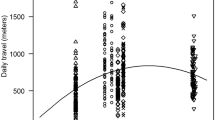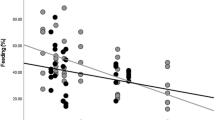Abstract
Small animals differ from large animals in their relative and absolute metabolic requirements and energetic expenditures. A preliminary study of the behavioral effects of these size dependent variables were investigated in two arboreal, sympatric and frugivorous anthropoid species:Macaca fascicularis andPongo pygmaeus. Data on both species were collected in East Kalimantan, Indonesia during a 20-month field study which focused onM. fascicularis. There are marked size dependent behavioral differences between the two species which show the constraints of large body size.
Existing hypotheses of the selective advantage of large body size in the orang-utan have either overlooked its advantages by describing it as a remnant of Pleistocene terrestriality and predator defense or attributed its advantage to greater access to resources. Contrasts between the energetics of foraging in the monkey and the ape suggest an alternate hypothesis for selection of large body size relating to the increased capacity of large body size to store fat energy and to subsist on lower quality foods in a relatively marked spatial-temporal unpredictable microhabitat of fruiting and flowering trees. Body size and energetics may play an important role in our models of the evolution of behavior and in the evolution of the great apes.
Similar content being viewed by others
References
Bell, R. H. V., 1971. A grazing ecosystem in the Serengetti.Sci. Amer., 225: 86–93.
Bray, G. A. &D. A. York, 1979. Hypothalamic and genetic obesity in experimental animals: an autonomic and endocrine hypothesis.Physiol. Rev., 59(3): 719–809.
Cahill, G. F., Jr., 1970. Starvation in man.New Eng. J. Med., 282: 668–675.
Calow, P., 1979. The cost of reproduction—a physiological approach.Biol. Rev., 54: 23–40.
Clutton-Brock, T. H., &P. H. Harvey, 1977a. Species differences in feeding and ranging behaviour in primates. In:Primate Ecology,T. H. Clutton-Brock (ed.), Academic Press, London, pp. 557–584.
————, & ————, 1977b. Primate ecology and social organization.J. Zool., London, 183: 1–39.
Coelho, A. M., Jr., L. S. Coelho, C. A. Bramblett, S. S. Bramblett &L. B. Quick, 1976. Ecology, population characteristics and sympatric association in primates: a socio-bioenergetic analysis of howler and spider monkeys in Tikal, Guatemala.Yb. Phys. Anthropol., 20: 96–135.
————,C. A. Bramblett &L. B. Quick, 1979. Activity patterns in howler and spider monkeys: an application of socio-bioenergetic methods. In:Primate Ecology and Human Origins,I. S. Bernstein &E. O. Smith (eds.), Garland STPM Press, New York, pp. 175–199.
Colwell, R. K., 1974. Predictability, constancy and contingency of periodic phenomena.Ecology, 55: 1148–1153.
Cope, E. D., 1986.The Primary Factors of Organic Evolution. Open Court Pub. Co., Chicago.
Crockett, C. M. &W. L. Wilson, 1980. The ecological separation ofMacaca nemestrina andM. fascicularis in Sumatra. In:The Macaques: Studies in Ecology, Behavior and Evolution,D. G. Lindburg (ed.), Van Nostrand Reinhold Co., Princeton, pp. 148–181.
Direktorat Perencanaan, 1973.Survey Kelompok Hutan, Muara Badak-Sungei Santan Departemen Pertanian. Laporan No. 352.
Dobzhansky, T., F. J. Ayala, G. L. Stebbins &J. W. Valentine, 1977.Evolution. W. H. Freeman & Co., San Franciso.
Drozdz, & A. Osiecki, 1973. Intake and digestibility of natural foods by roedeer.Acta Theriol., 18(3): 81–91.
Eckhardt, R. B., 1975. The relative body weights of Bornean and Sumatran orangutans.Amer. J. Phys. Anthropol., 42: 349–350.
Fedak, M. A. &H. J. Seeherman, 1979. Reappraisal of energetics of locomotion shows identical cost in bipeds and quadrupeds including ostrich and horse.Nature, 282: 713–716.
Fooden, J., 1971.Report on Primates Collected in Western Thailand. Fieldiana Zoology,Vol. 59, No. 1. Field Museum of Natural History, Chicago.
————, 1976. Primates obtained in peninsular Thailand June–July 1973, with notes on the distribution of continental southeast Asian leaf-monkeys (Presbytis)Primates, 17: 95–118.
Galdikas, B. M. F., 1978. Orangutan adaptation at Tanjung Puting Reserve, central Borneo. Unpub. doctoral dissertation, Univ. of California, Los Angeles.
————, 1979. Orangutan adaptation at Tanjung Puting Reserve: mating and ecology. In:The Great Apes,D. A. Hamburg &E. R. McCown (eds.), Benjamin/Cummings Pub. Co., Menlo Park, pp. 194–233.
Gaulin, S. J. C. &M. Konner, 1977. On the natural diet of primates including humans. In:Nutrition and the Brain, Vol. 1,R. J. Wurtman &J. J. Wurtman (eds.), Raven Press, New York, pp. 1–86.
———— &J. A. Kurland, 1976. Primate predation and bioenergetics.Science, 191: 314–315.
Geist, V., 1977. A comparison of social adaptations in relation to ecology in gallinaceous bird and ungulate societies.Ann. Rev. Ecol. Syst., 8: 193–207.
Gibbons, J. D., 1976.Nonparametric Methods for Quantitative Analysis. Holt, Rinehart & Winston, New York.
Grand, T. I., 1976. Differences in terrestrial velocity inMacaca andPresbytis.Amer. J. Phys. Anthropol., 45: 101–108.
————, 1977a. Body weight: its relation to tissue composition, segment distribution and motor function. I. Interspecific comparisons.Amer. J. Phys. Anthropol., 47: 211–239.
————, 1977b. Body weight: its relation to tissue composition, segment distribution and motor function. II. Development ofMacaca mulatta.Amer. J. Phys. Anthropol., 47: 241–248.
————, 1978. Adaptations of tissue and limb segments to facilitate moving and feeding in arboreal folivores. In:The Ecology of Arboreal Folivores,G. G. Montgomery (ed.), Smithsonian Institution Press, Washington, D. C., pp. 231–241.
Hamilton, W. J., III, &C. D. Busse, 1978. Primate carnivory and its significance to human diets.BioScience, 28(2): 761–766.
Harris, L. E., 1966.Biological Energy Interrelationships and Glossary of Energy Terms. National Academy of Sciences, National Research Council, Washington, D. C., Publication 1411.
Hays, W. L., 1973.Statistics for the Social Sciences. Holt, Rinehart & Winston, New York.
Hooijer, D. A., 1948. Prehistoric teeth of man and of the orang-utan from central Sumatra, with notes on the fossil orang-utan from Java and southern China.Zoologische Mededeelingen XXIX. E. J. Brill, Leiden, pp. 175–301.
————, 1949. Mammalian evolution in the Quaternary of southern and eastern Asia.Evolution, 3: 125–128.
Hylander, W. L., 1975. Incisor size and diet in Anthropoids with special reference to Cercopithecidae.Science, 189: 1095–1098.
Janzen, D. H., 1974. Tropical blackwater rivers, animals and mast fruiting by the Dipterocarpaceae.Biotropica, 6(2): 69–103.
Kay, R. F., 1975. The functional adaptations of primate molar teeth.Amer. J. Phys. Anthropol., 43: 195–216.
Kleiber, M., 1961.The Fire of Life, an Introduction to Animal Energetics. Wiley & Sons, Inc., New York.
Kloss, B. C., 1908. The white-handed gibbon.R. A. Soc. J. Straits Branch, 50: 79–80.
Kurland, J. A., 1973. A natural history of the kra macaques (Macaca fascicularis Raffles, 1821) at the Kutai Nature Reserve, Kalimantan Timur, Indonesia.Primates, 14: 245–262.
Leigh, E. G. Jr., &N. Smythe, 1978. Leaf production, leaf consumption and the regulation of folivory on Barro Colorado Island. In:The Ecology of Arboreal Folivores,G. G. Montgomery (ed.), Smithsonian Institution Press, Washington, D. C., pp. 33–50.
Lytle, L. D., 1977. Control of eating behavior. In:Nutrition and the Brain, Vol. 2,J. J. Wurtman &R. J. Wurtman (eds.), Raven Press, New York, pp. 1–145.
MacKinnon, J., 1971. The orang-utan in Sabah today.Oryx, 11(2–3): 141–191.
————, 1974. The behaviour and ecology of wild orang-utans (Pongo pygmaeus).Anim. Behav., 22: 3–74.
————, 1977. A comparative ecology of Asian apes.Primates, 18: 747–772.
————, &K. S. MacKinnon, 1978. Comparative feeding ecology of six sympatric primates in west Malaysia. In:Recent Advances in Primatology,D. J. Chivers &J. Herbert (eds.), Academic Press, London, pp. 305–321.
Masoro, E. J., 1977. Lipids and lipid metabolism.Ann. Rev. Physiol., 39: 301–321.
Milton, K., 1978. Behavioral adaptations to leaf-eating by the mantled howler monkey (Alouatta palliata). In:The Ecology of Arboreal Folivores,G. G. Montgomery (ed.), Smithsonian Institution Press, Washington, D. C., pp. 535–549.
————, 1979. Factors influencing leaf choice by howler monkeys: a test of some hypotheses of food selection by generalist herbivores.Amer. Naturalist, 114: 362–378.
Moen, A. N., 1973.Wildlife Ecology. W. H. Freeman & Co., San Francisco.
Montagu, A., 1966. Obesity and the evolution of man.J. Amer. Med. Ass., 195(2): 105–107.
National Academy of Sciences, 1972. Nutrient requirements of the monkey. In:Nutrient Requirements of Laboratory Animals, Publication No. 10, National Academy of Sciences, Washington, D. C., pp. 29–45.
Newsholme, E. A. &C. Start, 1973.Regulation in Metabolism. Wiley & Sons, Inc., New York.
Pianka, E. R., 1976. Natural selection of optimal reproductive tactics.Amer. Zool., 16: 775–784.
Pond, C. M., 1978. Morphological aspects and the ecological and mechanical consequences of fat deposition in wild vertebrates.Ann. Rev. Ecol. Syst., 9: 519–570.
Rensch, B., 1960.Evolution above the Species Level. Columbia Univ. Press, New York.
Richards, P. W., 1966.The Tropical Rain Forest. Cambridge Univ. Press, London.
Rijksen H. D., 1978.A Fieldstudy on Sumatran Orangutans (Pongo pygmaeus abeliiLesson 1827). H. Veenman & Zonen B. V., Wageningen.
Rodman, P. S., 1977. Feeding behavior of orang-utans of the Kutai Nature Reserve, East Kalimantan. In:Primate Ecology,T. H. Clutton-Brock (ed.), Academic Press, London, pp. 383–413.
————, 1978. Diets, densities and distributions of Bornean primates. In:Ecology of Arboreal Folivores,G. G. Montgomery (ed.), Smithsonian Institution Press, Washington, D. C., pp. 465–478.
————, 1979. Individual activity patterns and the solitary nature of orang-utans. In:The Great Apes,D. A. Hamburg &E. R. McCown (eds.), Benjamin-Cummings Pub. Co., Menlo Park, pp. 234–255.
————, 1981. Nutrition of wild and captive orang-utans. In:Handbook of Nutrition,M. Rechcigl (ed.), Chemical Rubber Co., Cleveland. (in press)
Schmidt-Nielsen, K., 1972,How Animals Work. Cambrigde Univ. Press, London.
Schultz, A. H., 1968. The recent hominoid primates. In:Perspectives on Human Evolution I,S. L. Washburn &P. C. Jay (eds.), Holt, Rinehart & Winston, New York, pp. 122–195.
Simpson, G. G., 1953.The Major Features of Evolution. Simon & Schuster, New York.
Smith, R. J. &D. R. Pilbeam, 1980. Evolution of the orang-utan.Nature, 284: 447–448.
Southwick, C. H. &F. C. Cadigan, Jr., 1972. Population studies of Malaysian primates.Primates, 13: 1–18.
Stanley, S. M., 1973. An explanation forCope's rule.Evolution, 27(1): 1–26.
Susman, R. L., 1974. Facultative terrestrial hand postures in an orangutan (Pongo pygmaeus) and pongid evolution.Amer. J. Phys. Anthropol., 40: 27–38.
Taylor, C. R., S. L. Caldwell &V. J. Rowntree, 1972. Running up and down hills: some consequences of size.Science, 178: 1096–1098.
Tuttle, R. H. &J. V. Basmajian, 1974. Electromyography of forearm musculature in gorilla and problems related to knuckle-walking. In:Primate Locomotion,F. A. Jenkins,Jr. (ed), Academic Press, New York, pp. 293–347.
Walike, B. C., C. J. Goodner, D. J. Koerker, E. W. Chideckel &L. W. Kalnasy, 1977. Assessment of obesity in pig-tailed monkeys (Macaca nemestrina).J. Med. Primatol., 6: 151–162.
Wassersug, R. J., H. Yang, J. J. Sepkoski, Jr. &D. M. Raup, 1979. The evolution of body size on islands: a computer simulation.Amer. Naturalist, 114(2): 287–295.
Weiner, J. S., 1964. Nutritional ecology. In:Human Biology,G. A. Harrison,J. S. Weiner,J. M. Tanner &N. A. Barnicot (eds.), Oxford Univ. Press, Oxford, pp. 400–423.
Wheatley, B. P., 1979. Riverine secondary forest in the Kutai Nature Reserve, East Kalimantan, Indonesia.Malayan Nat. J., 32(1): 19–29.
————, 1980. Feeding and ranging of east BorneanMacaca fascicularis. In:The Macaques: Studies in Ecology, Behavior and Evolution,D. G. Lindburg (ed), Van Nostrand Reinhold Co., Princeton, pp. 215–246.
Whitmore, T. C., 1975.Tropical Rain Forests of the Far East. Clarendon Press, Oxford.
Williams, M. H., 1976.Nutritional Aspects of Human Physical and Athletic Performance. C. C. Thomas, Springfield.
Wood, G. H. S., 1956. The dipterocarp flowering season in north Borneo, 1955.Malayan For., 19: 193–201.
Young, R. A., 1976. Fat, energy and mammalian survival.Amer. Zool., 16:699–710.
Author information
Authors and Affiliations
About this article
Cite this article
Wheatley, B.P. Energetics of foraging inMacaca fascicularis andPongo pygmaeus and a selective advantage of large body size in the orang-utan. Primates 23, 348–363 (1982). https://doi.org/10.1007/BF02381319
Received:
Accepted:
Issue Date:
DOI: https://doi.org/10.1007/BF02381319




